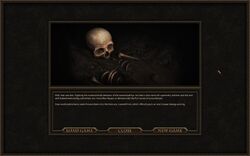Project Eternity Kickstarter Update #60: Chris Avellone on Companion Design
Project Eternity Kickstarter Update #60: Chris Avellone on Companion Design
Development Info - posted by Infinitron on Wed 24 July 2013, 12:44:32
Tags: Arcanum: of Steamworks and Magick Obscura; Chris Avellone; Obsidian Entertainment; Pillars of Eternity; Torment: Tides of NumeneraIn this week's Project Eternity Kickstarter update, Chris Avellone writes about aspects of companion design in both Project Eternity and Torment: Tides of Numenera. It's a long and highly technical update, revealing the professional side of MCA that we don't often see beneath his jokey exterior. Here's an excerpt:
Chris has also finally recorded Season 2 of his Arcanum LP:
Check out the full update for more MCA and more MCA drawings.
...and now on to Companion Design
We discussed companion design (http://forums.obsidian.net/blog/1/entry-168-project-eternity-and-characterization/) way back at the start of Eternity, so some points in this update will callback to this. There shouldn’t be a need for a refresher read unless you want to. The process for Eternity (and Torment) has followed these bulletpoints, and we’re holding true to our goals as well as expanding the design methodology as we go ahead.
The first and best place to start with companion design is the game systems. For companions, this means considering race, class, and their role in the conflict mechanics of the game. Knowing what class of character you’re making is key to building their history and personality. For example, in the case of Gann in NX1: Mask of the Betrayer, knowing his class before writing was a big help, and I can use that class’s list of abilities, class focus, and the abilities the class specializes in and weave it in with the backstory. The Eternity designers have been good about indicating the spread of classes and races for the companions and rationing those out during the process.
For Eternity, since combat is the primary challenge mechanic, one major goal is to make sure the companion is combat effective. Why would you take them in your party? How are they useful? In other instances of conflict mechanics (for example, dialogue or Tide reactivity in Torment), we also examine how the character is useful in terms of these challenges as well.
A Note About Challenge Mechanics
Really quick, I want to clarify what I meant about “challenge mechanics.” That doesn’t always mean combat – it’s whatever the primary challenge in the game is. If we were doing a Thief-style RPG, then stealth and avoiding detection becomes the primary challenge mechanic, not combat. Depending on the RPG and its range of challenges, a character can still be fairly weak in combat, but if that’s the case, we try to think of how they’re helpful with regards to the game’s other challenges (giving an edge in dialogue, healing, fast travel).
For all the characters I’ve seen or designed for games that don’t cater to at least one of the game’s primary challenge mechanics, those guys are often unpopular or unused because they’re not helping out with the systematic gameplay, regardless of how cool they might seem. And the more actively these characters can participate in the mechanics (vs. passive), the stronger their appeal.
Also at the same time, I try to be careful that the companion's skill set doesn’t overlap with the challenge roles of the other characters. We try to indicate in the companion briefs how each companion's challenge role is intended – one thing I learned as a pen-and-paper Gamemaster is you want to be careful about two players sharing the same role (Tank, Mage, Priest, etc.) – if one is clearly stronger than another, then the second one needs something else to make them stand out and be “special” in the party and fulfill an equally cool role in the party dynamic, otherwise one ends up getting upstaged by the other. And feelings get hurt. Which isn’t something you want in a game designed to entertain.
For Eternity, we’re setting it up so even if players choose the same classes as some companions, the companions are designed to assist those character types and make them more special (ciphers, for example, can chain, and even priests with the same religion can discuss theology and combo attacks).
Chris has also finally recorded Season 2 of his Arcanum LP:
Check out the full update for more MCA and more MCA drawings.
There are 16 comments on Project Eternity Kickstarter Update #60: Chris Avellone on Companion Design













